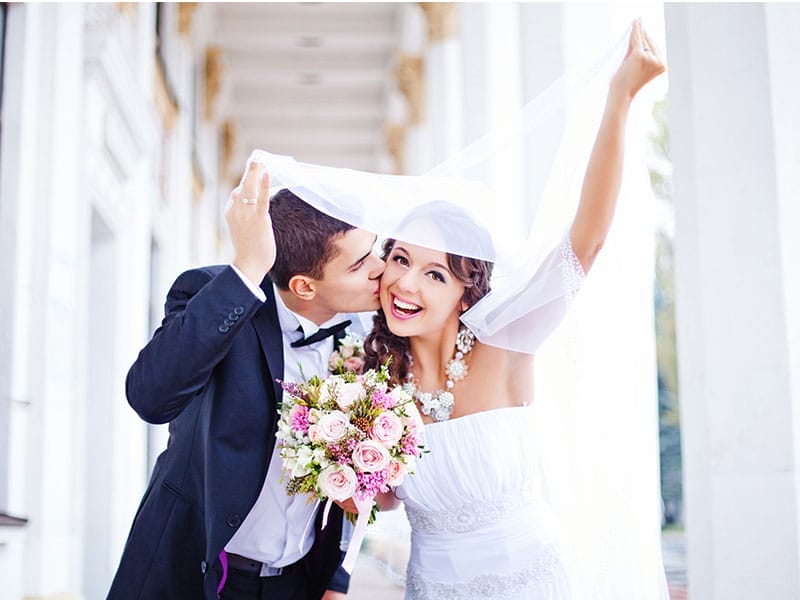
The Origins and Meanings of American Wedding Traditions
Weddings are a time of joy and celebration, marking the union of two people in love.
But beyond the romance, every clink of glasses and exchange of vows is steeped in tradition.
Many couples planning their big day find themselves curious about the “why” behind these age-old customs.
Why do brides wear veils?
What’s the deal with all those cake layers?
If you’ve ever been puzzled by the myriad wedding traditions at American ceremonies, you’re not alone.
Did you know that Queen Victoria set off an enduring fashion trend when she chose to wear a white gown for her wedding to Prince Albert back in 1840?
This sparked a craze for white wedding dresses that continues to this day!
Our article peels back history’s curtain to reveal fascinating stories like these; tales hidden behind each ritual we take for granted during nuptials.
As we dive into explanations from ‘something old’ to tossing bouquets and beyond, you’ll unravel secrets that will give your special day even more significance.
Discover how these rituals can add depth and personal flavor to your own ceremony!
Key Takeaways
- Bridesmaids once protected the couple from harm, which explains their presence and matching dresses at weddings today.
- The bouquet a bride carries has roots in ancient times when its scent was meant to ward off evil spirits; it now represents new beginnings and fertility.
- The wedding veil, historically a symbol of modesty and protection, is still worn by many brides for its romantic tradition.
- Rings are worn on the \”ring finger\” because of an ancient belief that it contains a vein leading directly to the heart, symbolizing love and commitment.
- Tossing rice at newlyweds originates from ancient cultures as a wish for fertility and prosperity in their marriage.
The Concept of Wedding Traditions
Moving from the broader overview, let’s delve into wedding traditions which stand as timeless rituals.
These customs are woven into the very fabric of the wedding ceremony and reception, creating a tapestry of practices that honor love and commitment.
Wedding traditions serve as landmarks for one of life’s most significant milestones, often symbolizing good fortune and happiness for the married couple.
They span everything from wearing rings on a specific finger to sharing slices of wedding cake with guests.
Each element carries its own story, rooted in history yet evolving over time to suit contemporary values.
Bridal bouquets once thought to ward off evil spirits now add beauty and personal expression to a bride’s march down the aisle.
The best man and bridesmaids who have roles during a wedding day are remnants from times when they protected the couple from harm or runaway spouses!
Unpacking these elements gives us insight into why we celebrate weddings in such elaborate fashions today.
Origins and Meanings of Popular American Wedding Traditions

The origins and meanings of popular American wedding traditions reveal the deep cultural significance behind these practices.
From the symbolism of \”something old, something new, something borrowed, something blue\” to the tradition of giving the bride away, each custom holds a special meaning that adds depth and richness to the wedding ceremony.
“Something old, something new, something borrowed, something blue”
Brides often embrace the tradition “something old, something new, something borrowed, something blue” on their wedding day.
This custom has charmed newlyweds for centuries and carries a basket full of good luck charms into marriage.
“Something old” represents continuity with the bride’s past and honors her family history.
Turning to “something new,” brides look forward to success in their future lives as partners.
Borrowing an item usually from someone happily married infuses the union with that couple’s own happiness and good fortune; this is where “something borrowed” comes into play.
Lastly, “something blue” stands for fidelity and love—qualities essential to any lasting relationship.
Incorporating these elements can range from subtle to overtly creative – think vintage lockets tucked into bouquets or sky-blue nail polish hidden beneath elegant gloves.
Each piece serves as a tangible wish for stability, joy, enduring love, and prosperity within the maze of matrimonial bliss.
Carefully chosen by brides or gifted by friends and relatives close to her heart, these symbols stitch together various aspects of life’s rich tapestry as she steps forward into wedded unity.
Carrying a bridal bouquet
A bridal bouquet is a vibrant collection of flowers that the bride carries down the aisle.
This tradition has deep roots, originating from ancient times when brides would clutch herbs and spices to ward off evil spirits.
Over time, these practical bunches transformed into the stunning floral arrangements seen in weddings today.
They symbolize new beginnings, fertility, and hope for happiness.
Choosing the right flowers for a bouquet can be meaningful as well. Each bloom may convey a special message or sentiment according to Victorian flower language.
For instance, roses stand for love while lilies represent purity.
The bouquet not only adds a touch of beauty but also carries with it an array of silent wishes for the couple’s future life together.
Bridesmaids in matching dresses
At many weddings, after the bride’s bouquet has been gracefully carried down the aisle, attention turns to traditionally dressed bridesmaids.
Bridesmaids in matching dresses are a common sight at American weddings, with their coordinated attire adding a touch of visual harmony to the celebration.
These matching dresses not only contribute to the overall aesthetic of the wedding but also symbolize unity and support for the bride as she takes this momentous step in her life.
Coordinating bridesmaid dresses often reflect the theme or color scheme of the wedding, creating a cohesive look for the bridal party that complements the bride’s gown and enhances the overall atmosphere of joy and solidarity on this special day.
Wearing a wedding veil
In American wedding traditions, wearing a wedding veil holds symbolic significance.
The veil has been historically linked to the concept of modesty and purity, symbolizing the bride’s innocence and her transition into marriage.
It also served as a form of protection from evil spirits or bad luck.
Additionally, the unveiling moment during the ceremony represents the groom’s anticipation and excitement in seeing his bride for the first time on their wedding day.
The tradition of wearing a wedding veil continues to be a meaningful and cherished part of many modern weddings.
Brides often choose veils that complement their gown and overall bridal look while embracing this age-old custom that adds an element of romance and tradition to their special day.
Wearing the ring on the “ring finger”
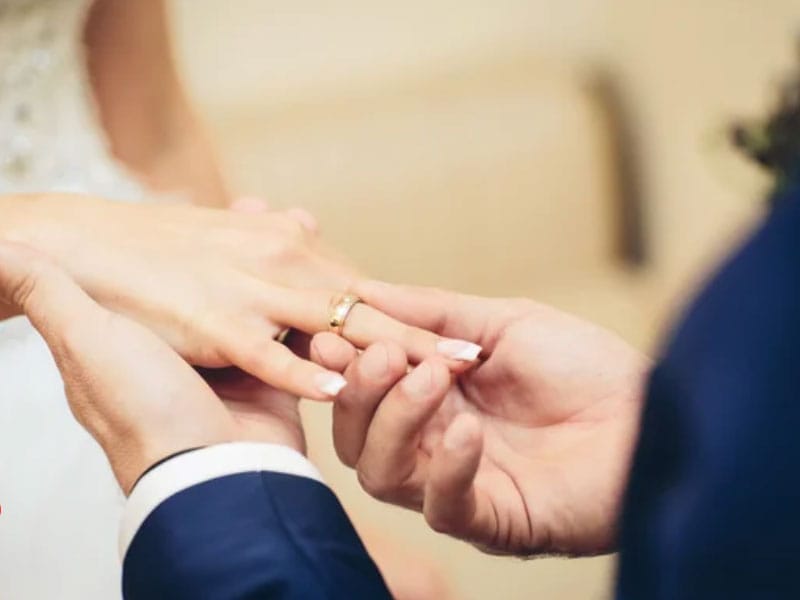
The tradition of wearing the wedding ring on the “ring finger” dates back thousands of years, with ancient civilizations believing that this specific finger contained a vein leading directly to the heart.
As a result, it became symbolic of love and commitment in marriage.
This tradition has endured over time and is now an integral part of modern wedding ceremonies, symbolizing the eternal bond between two people.
The exchange of rings during the wedding ceremony signifies not only the union itself but also serves as a visible reminder of the couple’s pledge to one another.
In American weddings, wearing the ring on the “ring finger” is a cherished and meaningful ritual that holds deep symbolism for couples embarking on their lifelong journey together.
Mailing printed wedding invitations
Continuing the tradition of sending out printed wedding invitations, couples often choose to personalize these cards to reflect their unique style and the theme of their special day.
Including elegant calligraphy or intricate designs can add a personal touch that sets the tone for what guests can expect at the event.
Additionally, inviting loved ones through physical mail creates a sense of formality and anticipation, marking the celebration as a significant moment in both the couple’s lives and those of their guests.
“Giving” the bride away
The tradition of “giving” the bride away dates back to ancient practices when daughters were considered property.
The father walking the bride down the aisle symbolizes his endorsement and support for her marriage.
Today, this tradition has evolved to also include other family members or even both parents accompanying the bride, signifying their collective blessings on her union.
In modern times, some couples have chosen to modify this tradition as a way to honor their unique family dynamics and individual beliefs.
Some brides choose to walk solo as an assertion of independence or are accompanied by someone who holds significant meaning in their lives, fostering a more inclusive and personal representation of love and support during this pivotal moment in the wedding ceremony.
This evolution reflects how weddings continue to adapt to changing cultural norms and societal values.
The phrase “tying the knot”
Traditionally, the phrase “tying the knot” refers to a ritual in which the couple’s hands are bound together with a cord or cloth during their wedding ceremony.
This practice symbolizes the couple’s commitment and unity as they embark on their marital journey, representing their bond and the unbreakable tie between them.
The term itself has origins in various cultures and is often linked to nautical imagery, where sailors would secure their love by tying knots that were difficult to untangle—a metaphor for lasting commitment.
Derived from an ancient Scottish marriage custom called “hand-fasting,” this phrase continues to be used today as a lighthearted way of referencing marriage.
It captures the sense of entwining two lives into one, encapsulating both strength and security within a loving partnership while celebrating unity at weddings across many cultures.
Tossing rice at the newlyweds
After “tying the knot,” another cherished American wedding tradition involves tossing rice at the newlyweds.
This practice has long been a symbol of fertility, prosperity, and good fortune for the couple’s future.
The act of showering the newly married pair with rice represents abundant blessings and well wishes as they begin their journey together.
Rice has held significance in many cultures around the world as a symbol of sustenance and fertility.
When guests toss rice at the bride and groom, they are not only offering their congratulations but also conveying their hopes for a prosperous and fruitful union.
The tradition of a wedding cake
The tradition of a wedding cake has deep historical roots symbolizing good luck and fertility.
Wedding cakes have been an integral part of celebrations, with tiers representing prosperity and the cutting of the cake signifying the couple’s first joint task.
And, feeding each other cake represents mutual support in their marriage journey.
Brides and grooms often personalize their wedding cakes to reflect their personalities or interests using unique designs, flavors, or decorations such as fresh flowers, intricate icing patterns, or even themed cake toppers.
Saving the top tier of the wedding cake
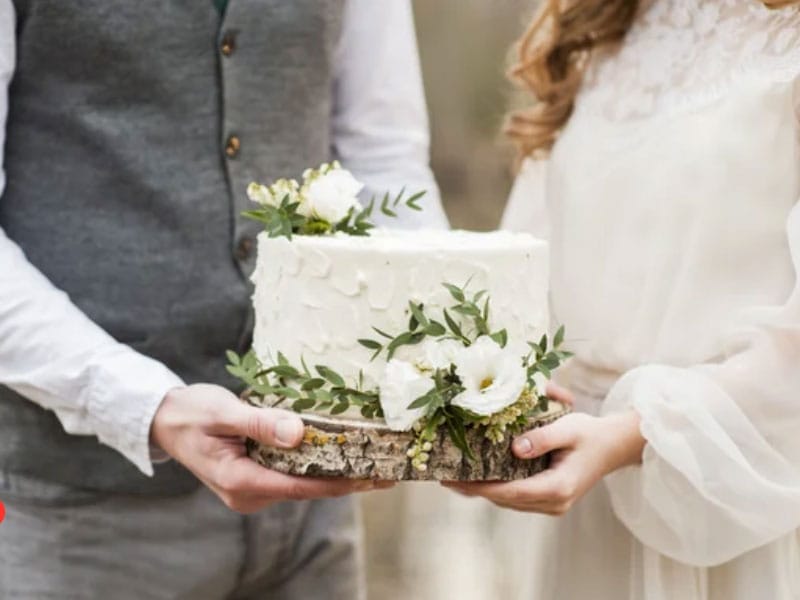
After the wedding, it is a tradition for couples to save the top tier of their wedding cake.
This practice symbolizes hope and happiness for the future.
Couples freeze this portion of the cake and share it on their first wedding anniversary as a way to revisit the joyous memories of their special day.
Preserving this slice also reflects the belief that marriage will endure through challenges, just like how freezing preserves food.
By cherishing this sweet reminder, couples honor and celebrate their enduring love while looking forward to many more years together.
Lesser-Known American Wedding Traditions
Buried bourbon, spiders on wedding dresses, using your married name before the wedding, sugar cube rituals, and ringing bells are just a few of the lesser-known American wedding traditions that have meaningful origins and symbolic significance.
Bury the Bourbon
To ward off rain on the wedding day, a rather charming American tradition involves burying a bottle of bourbon at the wedding site.
This custom is believed to ensure good weather for the special occasion.
According to this practice, one must bury an unopened bottle of bourbon upside down at the exact spot where the couple will exchange vows exactly one month before the ceremony.
The folklore states that retrieving and sharing this buried bourbon with friends and family on the big day brings clear skies and sunshine, adding an element of lighthearted fun amidst all wedding preparations.
A Spider on Your Wedding Dress
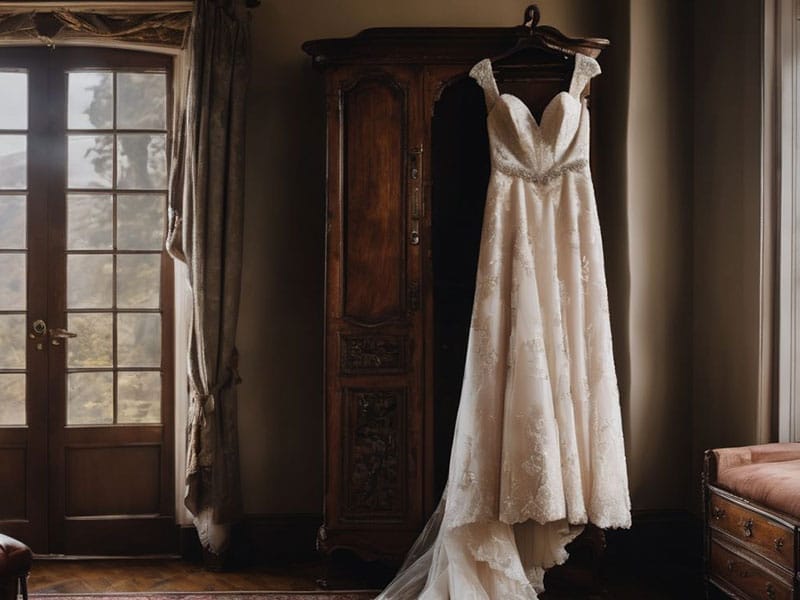
Moving from the Southern tradition of Bury the Bourbon, we encounter another intriguing American wedding custom: A Spider on Your Wedding Dress.
While it may seem alarming, this superstition holds a positive twist.
Finding a spider on your bridal gown is believed to bring good luck and prosperity in marriage.
This unique tradition adds an unexpected element to the wedding preparations, offering couples a whimsical story to share with their guests.
Despite its unconventional nature, A Spider on Your Wedding Dress remains a fascinating part of American matrimonial customs that showcases the diversity and complexity of wedding traditions across different regions.
While it’s not often discussed alongside well-known customs like bouquet tossing or cake cutting, embracing this quirky superstition can add character and charm to the overall wedding experience.
Using Your Married Name Before the Wedding
Before the wedding, some brides may feel eager to adopt their future spouse’s last name.
While it’s not official until after the ceremony, using your married name in social settings or on social media can symbolize a commitment to your upcoming marriage.
It can also be a way to help acquaintances make the transition and get used to addressing you with your soon-to-be marital surname.
Utilizing your married name before the actual wedding day is entirely personal and optional.
Some choose to embrace this change early as a means of celebrating and preparing for their new life ahead, while others prefer to keep their maiden name until they are officially married.
The Sugar Cube
The Sugar Cube tradition involves placing a sugar cube inside the bride’s glove or dress pocket.
This practice, dating back to the Victorian era, symbolizes the wishes for sweetness and good fortune in the couple’s future life together.
Ringing Bells
Ringing bells at weddings is an age-old tradition that symbolizes the joyous union of two individuals.
The pleasant chime of the bells is believed to ward off evil spirits and bring good luck to the newlyweds as they embark on their journey together.
In many cultures, the sound of ringing bells also signifies the start of a new chapter in the couple’s life, resonating with hope and happiness for their future.
This cheerful custom adds a delightful touch to wedding ceremonies, creating a festive atmosphere and spreading positive vibes among family and friends.
The tradition of ringing bells at weddings aligns with various superstitions and beliefs, contributing to the overall enchanting aura of this special occasion.
Whether it’s through handheld bells or larger church bell peals, this charming practice continues to be embraced by couples seeking to infuse their nuptials with symbolism and merriment.
Modern American Wedding Traditions
Thematic consistency is maintained throughout the content, so buckle up as we delve into the modern American wedding traditions.
From the popular tradition of throwing the garter to the significance of the first dance, these customs have evolved over time and continue to play a significant role in contemporary weddings.
Throwing the garter
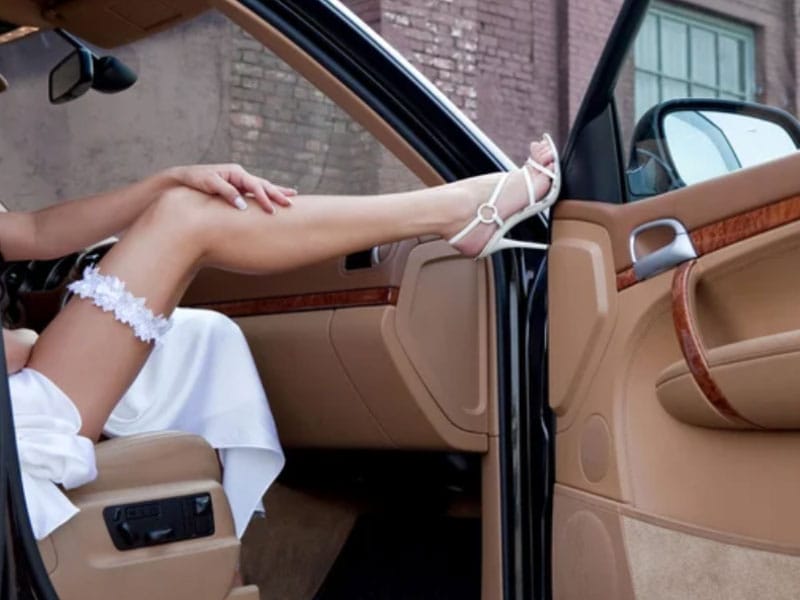
At modern American weddings, the tradition of throwing the garter adds a playful and lighthearted moment to the celebration.
After the bouquet toss, where the bride throws her bouquet to unmarried women, it’s now time for the groom to remove and toss his wife’s garter to unmarried men.
This light-hearted ritual symbolizes good luck and is said to bestow fertility upon the fortunate male recipient.
As part of this custom, whoever catches the garter is believed to be next in line for marriage—a superstition that continues to add an element of excitement and anticipation during wedding receptions.
In recent years, some couples have chosen to modify this tradition by allowing both partners to participate or by replacing it with alternative activities such as personalized games or dance-offs, making it a fun experience for everyone involved while maintaining cultural significance.
The first dance
The first dance is a cherished tradition at American weddings, symbolizing the newlywed couple’s union and their commitment to each other.
It often takes place after the cutting of the cake and signifies the beginning of celebrations as husband and wife.
The first dance provides an emotional moment for the couple to share with their loved ones, showcasing their love and unity as they move together in harmony on the dance floor.
Embracing this wedding tradition, couples carefully select a meaningful song that resonates with their relationship, creating a personal and intimate experience for themselves and their guests.
Cake topper
After the lively first dance, another cherished tradition at American weddings is the cake topper.
Placed atop the wedding cake, this decorative piece often represents the couple’s shared interests or a symbol of their love and commitment.
From classic figurines depicting a bride and groom in formal attire to more modern interpretations such as monogrammed initials or playful designs reflecting hobbies or professions, cake toppers add a personal touch to the sweet finale of the celebration.
The evolution of cake toppers mirrors changing societal norms and values, offering insight into cultural shifts surrounding marriage and individuality.
While some couples opt for traditional styles reminiscent of bygone eras, others embrace contemporary variations that reflect their unique personalities and beliefs.
Conclusion
In summary, American wedding traditions are steeped in history and symbolism.
Every tradition holds a special meaning that adds depth to the celebration of love and commitment.
Embracing these customs can add an element of tradition and significance to modern weddings.
Have you considered incorporating any of these traditions into your own wedding ceremony?
How might they enhance the ambiance and sentiment of your special day?
Understanding the origins and meanings behind these cherished practices can bring greater depth and purpose to your wedding festivities.
As you navigate through planning your special day, remember the richness that these traditions can bring to your celebration of love.
FAQs
Why do couples exchange wedding rings?
Couples exchange wedding rings as a symbol of their love and commitment. Traditionally worn on the fourth finger, this custom can be traced back to ancient times when it was believed that finger had a vein connected directly to the heart.
What’s the purpose of having a wedding party with bridesmaids and groomsmen?
The wedding party, which includes bridesmaids and groomsmen, is there to support the couple on their big day. Historically, they also had roles in protecting the bride from evil spirits or even would-be kidnappers!
Where did the idea of throwing a garter or bouquet come from?
Throwing a garter or bouquet comes from old traditions meant to bring good luck. The garter toss is linked to medieval times when guests would try to get a piece of the bridal dress for luck.
What do “something old, new, borrowed, and blue” symbolize in weddings?
These items are tokens of good fortune for the bride: something old represents continuity; something new offers optimism for her future; something borrowed symbolizes happiness; while something blue stands for purity and fidelity.
Can you tell me about some unique American wedding traditions?
American weddings often include unity candles where two flames become one—symbolizing union—or jumping over broom at African-American ceremonies which signifies sweeping away past wrongs.




